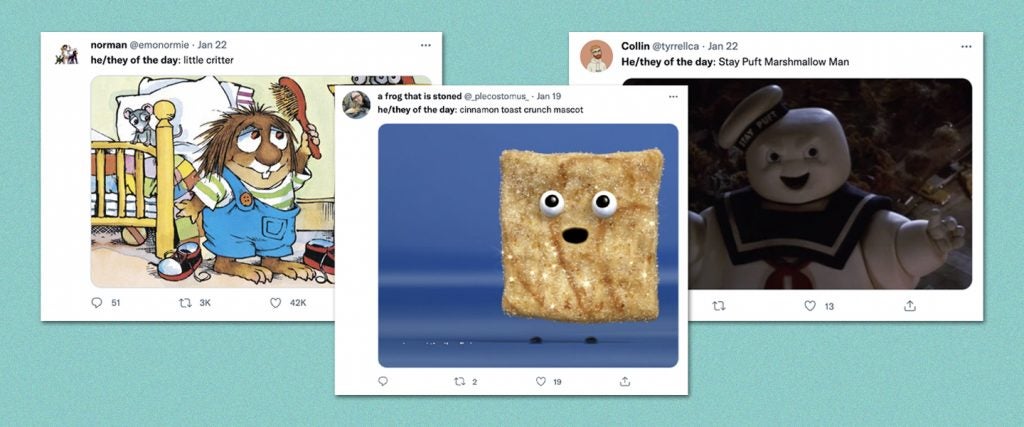Note: This article has been updated to include comments from Twitter’s @emonormie, who first created the meme.
It’s not particularly hard to refer to someone by their pronouns, and asking for this common courtesy shouldn’t provoke any sort of indignant horror. And yet pronouns themselves — a basically neutral part of language — have become, for right-wingers, an existential threat alongside Critical Race Theory, mask requirements and calls to defund police departments.
Much of this derives from simple transphobia and panic at the supposed loss of traditional gender archetypes. More broadly, however, the anti-pronoun gang refuses to let anyone develop or control their own identity: you’re only allowed to be what you look like to them, according to their few meager categories of personhood. So what if you took away their usual criteria for deciding someone’s gender? Maybe through the abstraction of art — like, say, a cartoon?
In recent months, declaring someone the “he/they of the day” has become a positive affirmation of those expressing both masculine and nonbinary qualities, as well as the flexibility to move between those. The concept was pioneered by Twitter’s @emonormie, who also uses he/they pronouns and operates as “founder & CEO” of the meme, taking submissions for the next pick.
“My first endeavor into he/they crafting began with myself, with the journey of exploring my own gender identity a few years ago,” Davies tells me in a private message. “Like a lot of other insufferable people, I started reading gender/queer theory, and not to be that guy/they, but reading Judith Butler’s Gender Trouble was a pivotal moment for me.” Eventually, Davies added a “they” to own their pronouns “because I deliberately wanted to distance myself from the concept of being a ‘man’ and as a way of drawing attention to and troubling those very categories of masculinity and maleness.”
Davies started posting a “he/they of the day” in October 2021, first getting some traction when they posited that Randall from Monsters Inc. is a he/they. For the purposes of the meme, the character in question is often an illustrated creature or mascot, in part because you wouldn’t want to label a real individual “he/they” if those weren’t their pronouns — but also because cartoons already occupy a zone of playful ambiguity. When you imagine the conservative who might attack a trans man for having “he/they” in their social media bio trying to argue that the anthropomorphic Dirty Bubble, a villain from SpongeBob SquarePants, is strictly male, the absurdity of their fixation becomes all the more obvious.
Drawings have no gender, of course, while animated series regularly employ men to voice feminine figures, and vice versa. The medium has long subverted our preconceptions of binaries and hierarchies to wonderful effect, imagining worlds that are all the richer for their open-ended approach to characterization. A limitless supply of “he/they” vibes is one byproduct — children’s books, cartoons and even board games include personalities who are perhaps canonically male, yet androgynous or queer-coded enough to take on they/them pronouns.
“In terms of looking at an animated/fictional character and deciding it’s a he/they, it’s of course pretty arbitrary; that’s just gender, baby,” says Davies. “Usually though, it’s like a guy who is kind of fucked up, or smelly, or fruity. A guy that’s untraditionally a guy, and therefore not necessarily fully a ‘guy’ at all — a he/they. Oogie Boogie from A Nightmare Before Christmas was he/they of the day because he’s a guy whose whole thing is being stinky and gross and made of bugs, but also in all these senses not a guy at all. He’s literally a knapsack or whatever.”
In the selection process, Davies takes pitches from friends along with inspiration from real life, and currently has too many DM submissions to keep track of — but he always delves into these when he can’t figure out a good selection for that day. “While I of course make no claims to inventing he/they pronouns or jokes in general, I absolutely take credit specifically for the the/they of the day phenomenon,” they say. “Is that insufferable? Without a doubt. But I have a stinky and nonnormative brand to maintain!”
“A lot of Gen Z fans have been responding to the he/theys of the day, saying the characters, especially the more abstract ones, are ‘so gender,’” Davies says. “ I think this phrasing speaks in a way to the whole phenomenon. Being and looking ‘so gender’ can of course be an intentional, genuine, deliberate contestation of rigid gender norms, but ‘he/they of the day’ is my attempt to show how gender can also be silly, gross, animated.”
Go ahead: Pick your favorite he/they from pop culture and let the rest of us know the proper ways to refer to him/them. You’ll be educating the public, advancing an important movement and, ideally, triggering some dipshit with bad facial hair who hasn’t taken his beanie off in months. Come to think of it, maybe he should try out “they/them” status too. There, does that feel better?

